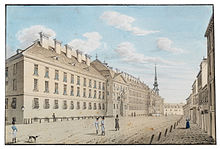Collegiate barracks
The Stiftskaserne , officially the Stiftskaserne General Spannocchi named after the officer Emil Spannocchi , also the office building Stiftgasse General Spannocchi , in the 7th district of Neubau, is a military building in Vienna. It is located at Stiftgasse 2 - 2a, a side street off Mariahilfer Straße . At the initiative of Defense Minister Thomas Starlinger , it was named after Emil Spannocchi on January 27, 2020.
history
17th century
The collegiate barracks goes back to a foundation of the wealthy Hofkammerrat Johann Konrad Richthausen Baron von Chaos for the benefit of orphans. In the suburb of Laimgrube , a house was built on a field, which was used as a summer home for the children.
In 1679 the so-called Mosertrakt was built along Mariahilfer Strasse, and in 1681 the property was surrounded by a wall. During the second Turkish siege of Vienna , the buildings were badly damaged, but made habitable again by 1687 and expanded with further additions by 1693.
After the pupils moved from the Chaos'sche Stiftungshaus on Kärntner Straße in Vienna , the complex was expanded again and a separate hospital floor was built in 1696 , so that the complex stretched from Mariahilfer Straße in the south to Spittelberg in the north.
18th century

In 1732 the so-called Moser wing was increased (in 1875 this wing was redesigned according to plans by Eugen Schweigel .) On February 4, 1735, the court bookkeeper Georg Franz von Griener handed over 20,000 guilders to the court chamber with the aim of training young men in war and engineering . From this foundation an engineering school developed in 1736 in cooperation with the Chaos Foundation, from which an engineering academy developed. Part of the foundation building was given to her. In 1739 the foundation stone for the collegiate church was laid. In 1746, the Duchess Maria Theresa von Savoyen-Carignan founded the Savoy Noble Academy . For this purpose, the Chaos Foundation acquired a strip of land behind the church and built the so-called “academy wing” - along today's Stiftgasse. At the same time, a riding school was built in the Stiftgasse / Siebensterngasse area . This academy was opened in 1749, placed under Maria Theresa in 1756 and merged with the Theresian Academy in 1776 .
The engineering academy, founded by Georg Franz von Griener, returned to the Chaos orphanage, where it had started, after moving several times.
19th century
In 1851 this engineering academy was relocated again, this time to Klosterbruck near Znojmo in South Moravia . Another wing (middle wing or sapper wing ) was built by 1853 and the building complex became the monastery barracks. Infantry was quartered in the sapper wing until 1875 . The kuk war school was housed in the collegiate barracks between 1859 and 1865. The infantry cadet school was up to their transfer to the 1869 infantry cadet school in Breitensee also based here in 1898. The KuK Technical Military Academy , which has also been in the collegiate barracks since 1869 , moved to a new building in Mödling in 1904 , which now houses the HTL Mödling .
20th century
The war archive and library from the war ministry were transferred to the rooms that had once been built for the Savoy Academy . After the two schools had moved out and large rooms had become vacant, troops of the Austro-Hungarian army were quartered here again, and until 1914 several staffs and inspectorates. During the First World War , the monastery barracks served as a hospital for the kuk medical services .
Immediately after the war, units of the people's armed forces were quartered here, but also liquidation offices. The armed forces followed later with infantry units, specialist courses and schools. In 1935 the monastery barracks became the location for parts of the newly established guard battalion .
During the Nazi era, the German Wehrmacht used the collegiate barracks and between 1943 and 1944 built the gun tower (G tower) here, which belongs to the fire control tower (L tower) in Esterházypark . During the occupation, US troops , including the military police , were stationed here. After 1955, the armed forces moved in here again , and departments of the Ministry of Defense followed later .
present
Today the collegiate barracks house the national defense academy , the editorial offices of the magazines “ Österreichische Militärische Zeitschrift ” and “ Truppendienst ”, the army picture and film office, the command and parts of the command support and cyber defense , the Austrian military library , the military ordinariate , the military superintendent and some departments of the Federal Ministry of Defense. A police station of the Federal Police , which has a separate entrance, is also housed in the building.
The collegiate barracks is also the namesake of the official statistics counting district of the same name, which consists of six counting districts.
literature
- Felix Czeike : Historical Lexicon Vienna. Volume 1: A – Da. Kremayr & Scheriau, Vienna 1992, ISBN 3-218-00543-4 .
- Manfried Rauchsteiner, Erwin Pitsch: The collegiate barracks in war and peace . Federal Ministry for National Defense, Vienna 1977, ( Austria's barracks 1).
Web links
Individual evidence
- ↑ Academies. In: bundesheer.at. Accessed January 30, 2020 .
- ^ Gerhard Vogl: New names for Viennese barracks. In: The press . December 26, 2019, accessed January 27, 2020 .
- ^ New names for Viennese barracks. In: ORF.at . January 27, 2020, accessed January 27, 2020 .
- ^ Vienna: Rossauer barracks and collegiate barracks got new names. In: DerStandard.at . January 27, 2020, accessed January 27, 2020 .
Coordinates: 48 ° 12 ′ 5.2 ″ N , 16 ° 21 ′ 20.6 ″ E


